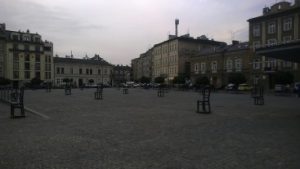In my Contemporary Art Issues class here in Newcastle, the professor began our initiation into the course with a seemingly simple question: What IS Contemporary Art? Many responded with the notion that contemporary art was art that was simply made in the here and now. The only criteria that was needed was for the artist to have made that piece in the present. Although the argument is valid and understandable, I found myself considering that for art to be Contemporary that it must not only be made in the present, but also react to the present.
Alex Seton, an Australian artist who works primarily in marble sculpture and installation, embodies this notion that contemporary art should react to the present human condition. His work is currently featured in the Newcastle Gallery of Art in a solo exhibition titled The Island, focusing on Australia’s role in the Syrian refugee crisis. Although I often assume that the viewer needs to have all of the context of a particular work in order to have an appropriate response, this exhibition made me reconsider this notion and the ways that art can create feelings of empathy regardless.
When the viewer first enters the space, they are met with a modest and poetic installation of what appears to be hundreds of paper sail boats arranged on the floor in a large circle. At first glance, the origami boats reminded me the hundreds of colored paper cranes at Hiroshima and all of the people that those cranes represented. These boats were different though, the choice of clean white paper prescribed this work with a pure, precious quality, of something that needed protection from someone with delicate hands.
At closer inspection, the viewer realizes that the piece, Blanco Armada (2015) , is actually entirely made of marble. Most of his works throughout this exhibition use a similar type of trompe-l’eoil technique as a way of confusing the viewer while also adding another level of nuance to the significance of each work. Consistent throughout his use of this technique is Seton’s dedication to reminding the viewer that the weight of the situation is more significant than it seems and, like ancient marble, will hang around for much longer than expected.
In The Body in Contemporary Art, Sally O’ Reilly states:
“No matter what our social, physical or emotional state, or political or religious allegiances, our common physiological experience enables us to empathize with the bodies of others.”
While viewing Seton’s piece Someone died trying to have a life like mine (2013), this was all I could think about. Seton’s piece consists of 28 marble lifejackets, strewn about the floor of a dim light gallery as if abandoned by its anonymous users. Each grouping is illuminated by a small beam of bright light, individual spotlights encouraging the viewer to ponder not only on the lifejackets themselves, but on the bodies that are no longer there. As the viewer begins to take notice of this absence and to imagine what became of the people who once clung to these jackets to save their lives, the viewer becomes overwhelmed.
Immediate connections transported me in space and time to places like the Ghetto Heroes Square in Budapest, where chairs are left abandoned after the ghetto was hastily liquidated in WWII to transport its inhabitants to the camps where they would eventually die. Places like Christian Boltanski’s installation of Personnes (2010) in Paris, where mountains of clothing memorializes the lives of those lost in anonymity and death. Lastly, this piece took me to Poland in June 2014 when I found myself face to face with mountains of abandoned prosthetic limbs inside the walls of the Auschwitz concentration camp.
In this work, like in the ones aforementioned, the use of artifacts or even the allusion to artifacts, confronts the viewer with a situation that is more than just the objects before them. The object becomes a fragment of the body it represents, a synecdoche, a looming ghost that confronts us with the possibility of death – both theirs and our own. Through this process, Seton utilizes the missing body and the fragments of that body to inspire empathy from the viewer and to trigger a response, hopefully in favor of rescuing those who these jackets represent.
Seton’s work, as it references both historical events and contemporary issues in order to provide commentary on the present human condition, embodies what I consider to be contemporary art. In cases such as this, the artist uses their art form not only as a vehicle for reacting to the current events that shape our world, but also to suggest a call to action in response to those events.
Until Next Time…




